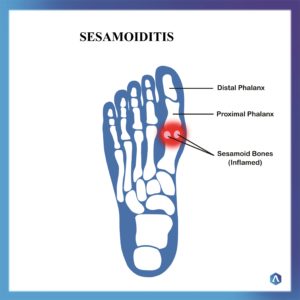Sesamoiditis
- Dr Abbie Clinics
- August 26, 2019

These bones are different to our other bones, which connect to each other via our joints. Sesamoids are connected to muscles by tendons and Sesamoiditis occurs when these get inflamed. These two floating bones can dislodge and become split so they mal-track, a cause of inflammation.
The sesamoid tendons can also become inflamed if repeated trauma occurs, such as wearing high heels or badly fitting shoes.
Excessive pronation and a condition called plantarflexed first, where the first metatarsal (toe bone) genetically sits dropped to the other metatarsals, can also place extra stress on the Sesamoids, causing Sesamoiditis.
Note that the largest Sesamoid in the body is the kneecap or patella. When the two tendons (patella tendon and quadriceps tendon) attached to the patella get inflamed it causes knee pain.
Symptoms
Pain in the ball of the foot is the key symptom and should not to be confused with metatarsalgia. You may experience swelling under the foot and that the pain increases slowly. You may also find it difficult to straighten or bend your big toe, or it might hurt. A feeling of popping the big toe when walking is also something to watch for.
Assessment
A physical examination is the first port of call for diagnosis and this could be part of a biomechanical assessment to check how the rest of your body is working together. If there is tenderness on the ball of the foot and movement of the big toe is limited this will help with diagnosis. To be certain there is no fracture an X-ray, CT, ultrasound or MRI may be prescribed.
Treatment
Rest, ice and over the counter anti-inflammatory medication are the first points of call. The approach also includes monitoring, footwear changes or orthotics.
- Monitoring physical activity and ensuring over use does not occur.
- Ice on the foot will help reduce swelling.
- Footwear helps in keeping the foot stable and balanced in everyday activities.
- Orthotics are corrective, medically prescribed innersoles, designed to support, control and align the foot whilst correcting mechanical issues from the feet up, treating the cause.Use of orthotic therapy is an excellent regime as it helps realign the body’s biomechanical structure and control any excess foot pronation, eliminating the pull that occurs at the insertion point. They also help stabilise the heel bone and the growth plate, taking pressure off the first ball of foot area, to decrease inflammation and pain.
- Anti-inflammatories – can reduce any inflammation caused by the spur and corticosteroid injections for severe cases are another approach.
- Foot mobilisation – this is used to fix any partially dislocated bones and other issues which may be causes of inflammation.
- Dry needling – is used to release any taut bands of soft tissue (muscles, tendons, ligaments) known as trigger points, scar tissue or adhesion areas which cause pain and discomfort.
- Strapping – can offer support to the injured area taking pressure off the point of inflammation.
If you or your child are experiencing any of the above symptoms call 1800 DR ABBIE or email reception@dr-abbie.com to organise an assessment.


